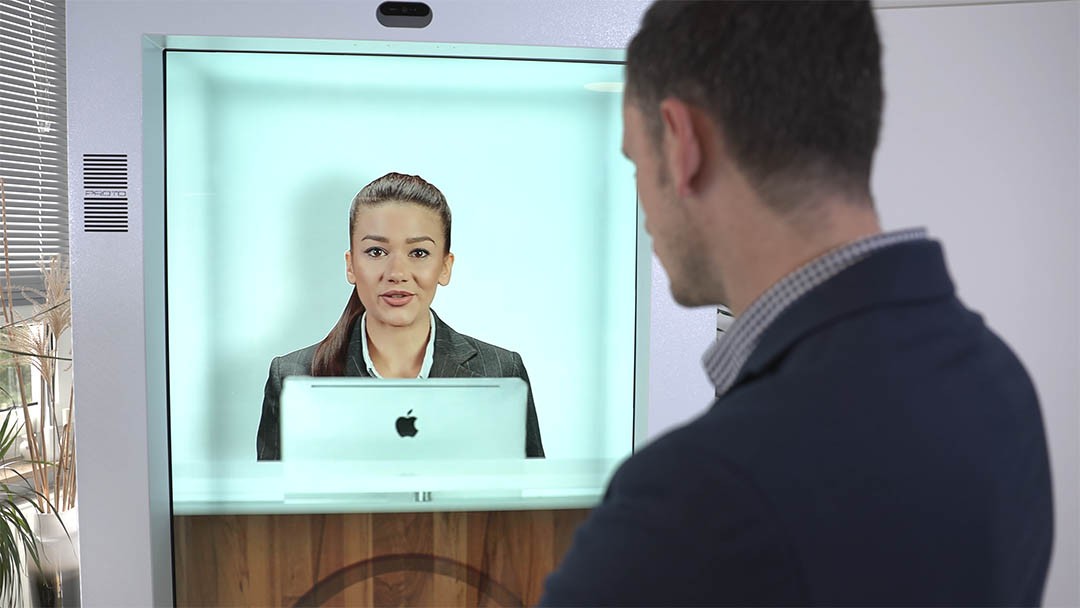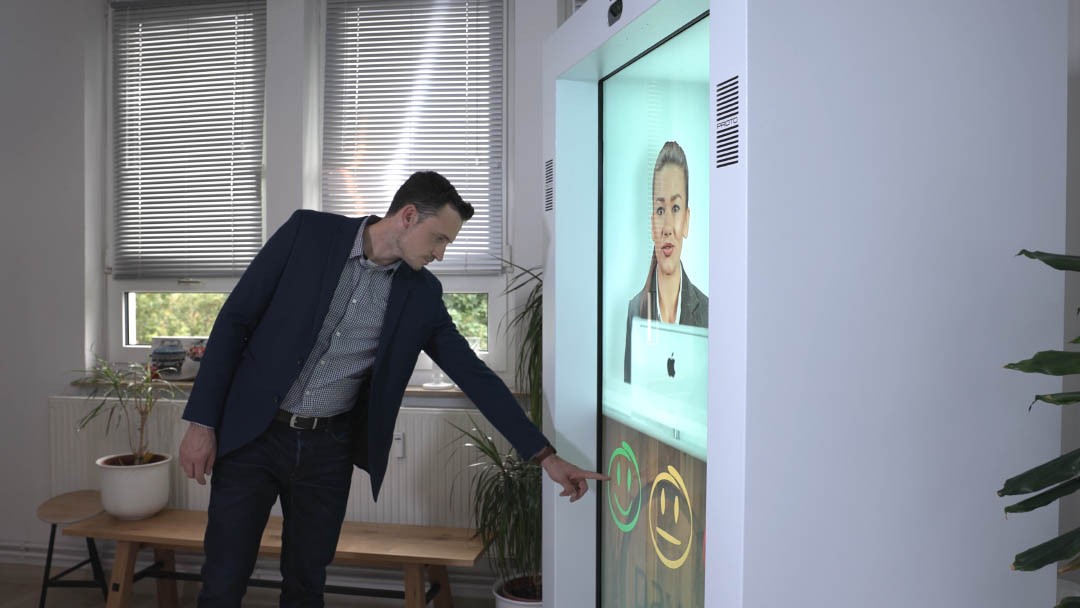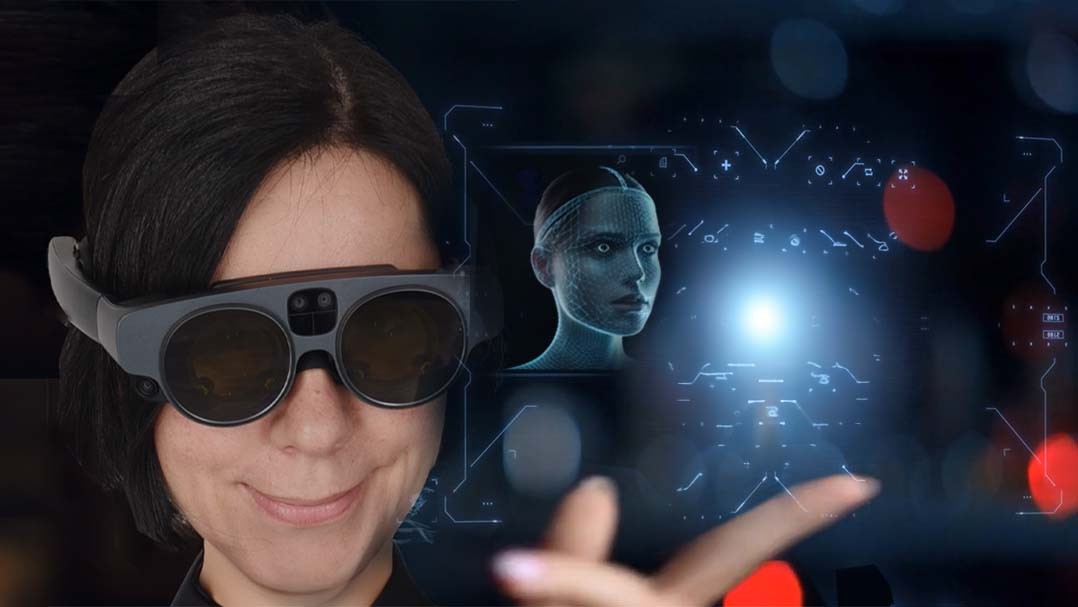Experts in 3D AI Service Apps
Discover new possibilities in customer service and support with our expertise in AI-driven 3D service apps.
- Full service: We accompany you from conception to operation. Implement interactive 3D interfaces for customer support or automate customer service in various industries.
- Customized solutions: Our technology is industry-independent and tailored specifically to your needs. From chatbots with 3D interaction to customized virtual customer service experiences – we make it possible.
- Technological edge: Set new standards with advanced AI-driven 3D service apps. Improve your customer engagement with interactive real-time analytics or use our technology for more efficient service processes.
Take advantage of our multidisciplinary expertise for innovative, secure, and interactive service experiences.
Visorics Expertise in Developing AI-Supported 3D Service Apps
What do our AI-supported 3D Service Apps offer?
Our focus is on developing innovative AI-supported 3D service apps that improve efficiency and customer experience across industries. From augmented reality applications for interactive customer service to VR-based support solutions – we offer tailor-made technologies that support your business goals. Are you ready for a technological leap? Contact us for forward-looking solutions.
Customized solutions for every need:
Our AI-supported 3D service apps are flexibly configurable and offer solutions tailored to your specific requirements. Do you need interactive 3D tools for your virtual showroom or customized VR support solutions? We provide you with the right technology.
New dimensions in customer service:
By integrating AI into 3D technologies, we open up innovative possibilities in customer service and support. Our 3D service apps offer everything from personalized AR interfaces to advanced digital support solutions, elevating your customer experience to a new level. Let yourself be inspired by the possibilities and contact us for more information.
Shape the future of digital customer interaction with us. Get in touch for a personalized consultation.
Maximize Your Business Success with AI-Supported 3D Service Apps
Operational efficiency through technological innovation: With our advanced AI-supported 3D service apps, technicians and service personnel gain direct access to interactive, holographic spare part representations and diagnostic tools, leading to significant cost savings and optimization of workflows.
Accelerated diagnostics and problem-solving: Our apps provide technicians with in-depth insights into technical systems through mixed reality and real-time analytics. These innovative solutions enable faster diagnostics and more precise troubleshooting.
Increasing customer satisfaction: Our user-friendly 3D service apps enable technicians to perform complex repairs and maintenance more efficiently and accurately. This leads to improved service quality and increased customer satisfaction.
Minimizing risks and increasing safety: Accurate and intuitive AI-supported 3D visualizations reduce errors in repairs and maintenance, increasing workplace safety and simultaneously minimizing liability risk for your company.
How to reach us!
Mail: info@visoric.com
Phone: +49 89 21552678
Contact person:
Ulrich Buckenlei (Creative Director)
Mobile +49 152 53532871
Mail: ulrich.buckenlei@visoric.com
Nataliya Daniltseva (Project Manager)
Mobile + 49 176 72805705
Mail: nataliya.daniltseva@visoric.com
Address:
VISORIC GmbH
Bayerstraße 13
D-80335 Munich

Questions about Service AI Apps
If you would like to learn more about the various applications and benefits of our AI-powered 3D service apps, we are happy to help. Do not hesitate to contact us! We look forward to your inquiry.
Applications of Service AI Apps in Business
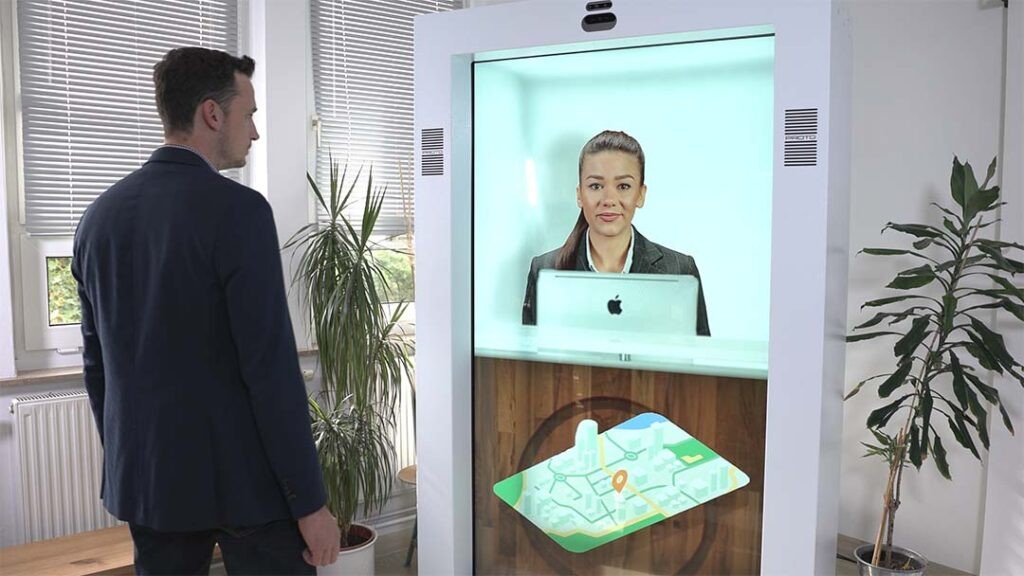
Customer Service with AI-Powered 3D Service Apps
Areas of Application:
- Interactive Customer Dialogue: Use of AI-powered 3D avatars for more personal and engaged customer communication.
- Automated Inquiry Processing: Efficient and rapid processing of customer inquiries through intelligent AI algorithms.
- Product Advice and Support: Detailed product presentations and assistance in 3D environments.
- Customer Feedback and Analysis: Collection and analysis of customer feedback for continuous improvement of service quality.
- Multichannel Support: Integration of AI service apps across various channels for comprehensive customer care.
Benefits:
- Personalization: Tailored customer care using AI-based personalization techniques.
- Efficiency Improvement: Acceleration of inquiry processing and reduction of waiting times for customers.
- Customer Loyalty: Strengthening customer relationships through high-quality and interactive service experiences.
- Scalability: Flexible response to customer inquiries, regardless of volume.
- Cost Efficiency: Reduction of operational costs through automation of recurring inquiries.
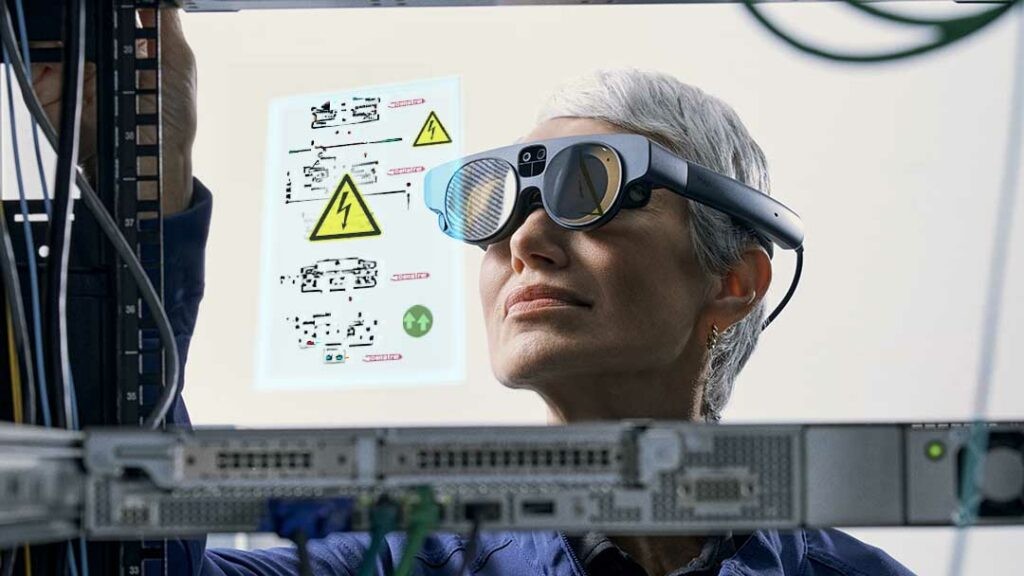
Technical Support with AI-Powered 3D Service Apps
Areas of Application:
- Mixed-Reality Instructions: Provision of interactive, step-by-step instructions for repairs and maintenance via MR glasses.
- Remote Assistance: Remote support by experts using AI-powered video and image analysis.
- Diagnostic Tools: AI-based diagnosis of machine problems and quick solution suggestions.
- Interactive Maintenance Manuals: Digital manuals with 3D visualizations for detailed insights and instructions.
- App-Based Support Solutions: Mobile applications for maintenance personnel for efficient on-site problem-solving.
Benefits:
- Improved Troubleshooting: Precise and quick identification of problems and their resolution.
- Time Saving: Reduction of downtime through rapid and effective support.
- Cost Saving: Decrease in the need for on-site visits through efficient remote support.
- Improved Training: Increased understanding and skills of maintenance personnel through interactive guides.
- Increased Customer Satisfaction: Quick and competent solutions boost trust and satisfaction among customers.
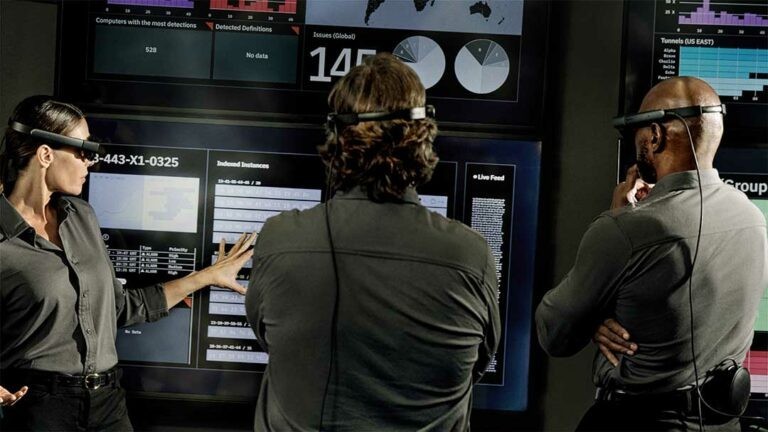
Training and Education with AI-Powered 3D Service Apps
Areas of Application:
- Interactive Learning Platforms: Development of AI-powered 3D environments for realistic training and simulations.
- Personalized Learning Paths: Use of AI to create individual learning programs based on the needs and progress of learners.
- Virtual Workshops: Conducting interactive online workshops and training with 3D models and simulations.
- Performance Tracking: Use of AI to analyze and assess learning progress and adjust learning content.
- Mobile Learning Applications: Provision of learning materials and interactive modules via apps for tablets and smartphones.
Benefits:
- Effective Learning: Enhancement of the learning experience through interactive and immersive technologies.
- Flexibility: Accessibility of training materials anytime and anywhere, also via mobile devices.
- Scalability: Adaptation of learning content to different group sizes and skill levels.
- Cost Efficiency: Reduction of training costs through virtual learning environments.
- Faster Skill Development: Acceleration of the learning process through personalized and practical learning approaches.
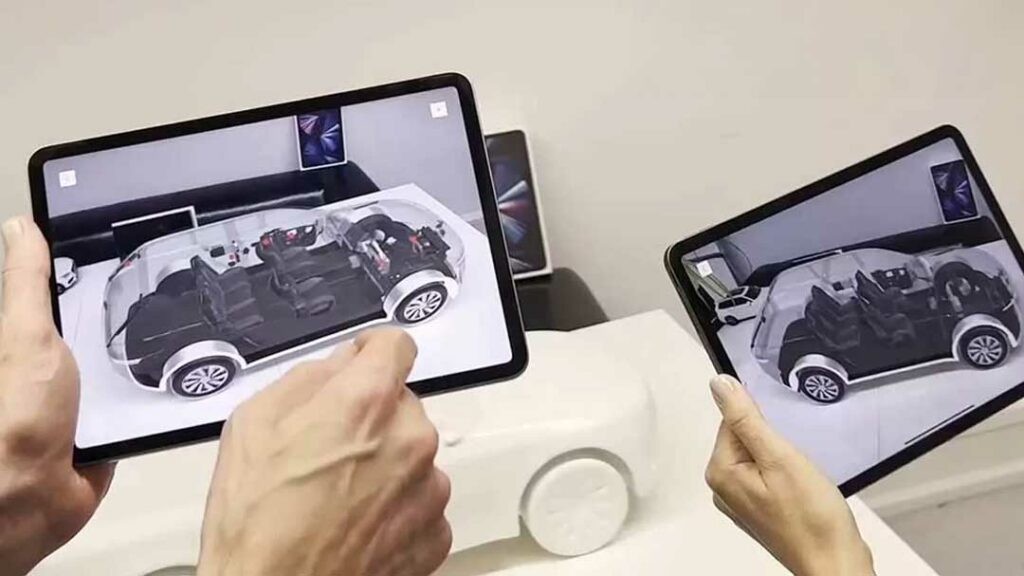
Product Presentation and Marketing with AI-Powered 3D Service Apps
Areas of Application:
- Virtual Product Demonstrations: Use of 3D models and virtual tours for an immersive presentation of products.
- Interactive Customer Experiences: Creation of personalized and interactive experiences to increase customer engagement.
- Targeted Marketing Campaigns: Use of AI to analyze customer data and develop tailored marketing strategies.
- Social Media and Digital Marketing: Integration of 3D content into social media and digital advertising platforms for increased visibility.
- Dynamic Product Customizations: Enabling customers to configure and customize products in real time.
Benefits:
- Enhanced Brand Perception: Improvement of brand presence through innovative and engaging 3D content.
- Increased Customer Interaction: Boost in customer interaction and engagement through interactive product presentations.
- Data-Driven Marketing: Targeted and effective marketing measures based on AI-supported data analysis.
- Cost Reduction: Reduction of marketing costs through digital campaigns and virtual presentations.
- Faster Market Introductions: Accelerated product launches and marketing campaigns through the use of digital tools.
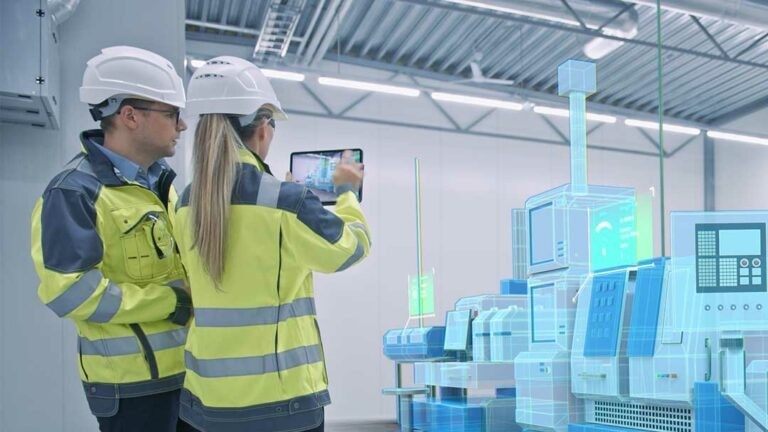
Operational and Process Optimization with AI-Powered 3D Service Apps
Areas of Application:
- Workflow Automation: Use of AI to optimize and automate recurring operational processes.
- Efficiency Analysis: Use of 3D simulations to analyze and improve operational efficiency.
- Resource Management: Intelligent management of resources and inventory through precise AI algorithms.
- Quality Assurance: Use of AI-powered tools to monitor and improve product quality.
- Predictive Maintenance: Prediction and prevention of machine failures through AI-based analyses.
Benefits:
- Productivity Increase: Improvement of overall productivity through more efficient processes and workflows.
- Cost Reduction: Reduction of operational costs through the automation and optimization of processes.
- Improved Operational Safety: Increase in workplace safety through preventive maintenance and quality controls.
- Rapid Response to Market Changes: Flexibility and adaptability to changing market conditions.
- Data-Based Decision Making: Use of AI-supported data analyses for informed decisions.

Research and Development with AI-Supported 3D Service Apps
Applications:
- Innovation promotion: Using AI and 3D technologies to accelerate innovation processes in product and technology development.
- Data-driven research: Utilizing AI algorithms to analyze and interpret large data sets to identify new insights and trends.
- Prototyping and modeling: Creating realistic 3D models and prototypes for rapid verification of concepts and designs.
- Simulation-based testing: Conducting tests and experiments in virtual environments to save time and resources.
- Collaboration and knowledge exchange: Facilitating collaboration between research teams through shared virtual workspaces.
Benefits:
- Accelerated development: Reducing the time from idea to market-ready product through efficient research and development processes.
- Cost reduction: Minimizing development costs through the use of virtual simulations and tests.
- Risk minimization: Early detection and resolution of potential problems in the development phase.
- Enhanced research quality: Improving the accuracy and reliability of research results through AI-supported analyses.
- Innovative solutions: Promoting creative and innovative approaches through advanced research opportunities.
Potential of AI-Supported 3D Service Apps in Core Areas:
- Revolutionizing customer service: Using AI-supported 3D technologies to create interactive and personalized customer experiences, elevating customer service to a new level.
- Technical support and maintenance optimization: Improving error diagnosis and resolution through interactive instructions and remote support, leading to reduced downtime and increased efficiency.
- Training and education with immersion: Developing customized and interactive training programs in virtual environments, making learning more effective and engaging.
- Innovative product presentation: Utilizing 3D technology for vivid and detailed product demonstrations that uniquely engage customers.
- Operational and process optimization: Using AI for automation and efficiency enhancement in operational processes, leading to significant time and cost savings.
- Research and development: Accelerating innovation processes and improving research quality through data-driven analyses and simulation-based testing.
Additional benefits:
- Superior data analysis and decision-making: AI-supported analysis of large data volumes enables more precise and informed decisions in all business areas.
- Increased customer interaction and engagement: Personalized and immersive experiences lead to stronger customer loyalty and higher satisfaction.
Explore Selected Examples of Our 3D AI Service App
Our fascination and enthusiasm have been dedicated to the development of high-performance, exceptionally realistic AI-supported 3D service apps for more than 14 years. We look forward to entering new levels of interactive and immersive user experience with you. Let’s create something extraordinary together.

Virtual Assistants for Holographic Displays – Best Practices
Innovative use of AI avatars on Proto M and Proto Epic displays
This reference project illustrates how photorealistic AI avatars on Proto M and Proto Epic holographic displays enable unique customer interactions.
Implementation and benefits:
Our custom virtual assistants offer lifelike interaction on holographic displays. They are capable of understanding and individually responding to customer inquiries.
Revolutionizing customer communication:
By integrating advanced AI technologies, these avatars dynamically respond to customer needs and offer a personal and interactive experience that far surpasses traditional digital interfaces.
Successes and increased engagement:
The use of these avatars has led to a significant increase in customer engagement and an improvement in brand perception across various industries.
Expanding service capacities:
In addition to improving customer service, these avatars open new opportunities for information dissemination and consultation by presenting complex content in an understandable and appealing way.
Additional benefits:
The photorealistic avatars on holographic displays not only provide a visually impressive experience but also set new standards in digital customer interaction.

Technical Support and Maintenance – Best Practices
Use of Mixed Reality in industrial maintenance
This reference project illustrates the innovative use of AI-supported 3D service apps in the area of technical support and maintenance in industry.
Implementation and benefits:
Our Mixed Reality application for maintenance technicians allows the visualization of machine components and maintenance instructions in real time via Smart Glasses. This significantly improves the accuracy and efficiency of maintenance work.
Facilitating complex repairs:
Through interactive, step-by-step instructions, technicians can independently and error-free carry out complex repairs. This leads to a reduction in downtime and optimization of the maintenance process.
Successes and efficiency improvement:
The introduction of this Mixed Reality application has led to a significant increase in maintenance efficiency and a reduction in downtime in various industrial projects. Technicians can respond faster and more precisely to problems.
Additional benefits:
The app not only provides support during maintenance but also enables precise documentation and analysis of the work carried out. This contributes to a continuous improvement of the maintenance processes and a long-term reduction in operating costs.
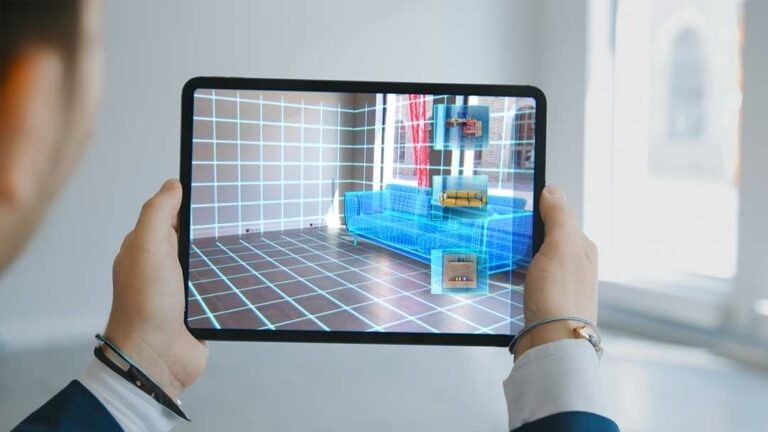
Interactive Customer Service – Best Practices
Innovative Augmented Reality Shopping App in Retail
This reference project demonstrates the advanced use of AI-supported 3D service apps in the area of interactive customer service in retail.
Implementation and benefits:
Our custom Augmented Reality (AR) Shopping App allows customers to view, configure, and virtually place products in 3D in their real environment. This leads to an improved customer experience and increased readiness to purchase.
Personalized shopping experiences:
The app uses AI to provide personalized product recommendations and adapts to user preferences and behavior. This increases customer satisfaction and fosters customer loyalty.
Successes and brand engagement:
The use of this AR app has led to a significant increase in engagement and dwell time in online shops for our customers. Brands were able to increase their conversion rates while simultaneously creating unique and unforgettable shopping experiences.
Additional benefits:
In addition to enhancing the sales experience, the app provides valuable insights into customer behavior. This data helps companies optimize their marketing strategies and better align future product developments with customer needs.
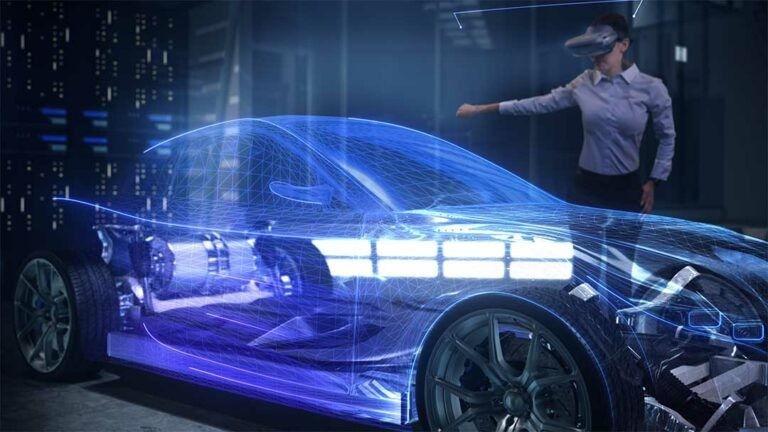
Innovative Product Development and Design – Best Practices
AI-Supported 3D Modeling and Prototyping in the Automotive Industry
These reference projects demonstrate the use of AI-supported 3D service apps in innovative product development and design.
Implementation and benefits:
In the automotive industry, we have implemented AI-supported 3D modeling and prototyping tools that accelerate the development process. Using virtual prototypes, design concepts can be quickly visualized and adjusted, leading to more efficient and cost-effective product development.
Optimizing design and functionality:
The technology allows for detailed and flexible design of vehicle models. This not only improves the design but also optimizes the functionality and performance of the vehicles.
Successes and market introduction:
Our reference projects show how companies have been able to shorten the time to market for their products through the use of these technologies. At the same time, the quality and attractiveness of the vehicles were increased.
Additional benefits:
Besides accelerating product development, these tools also enable comprehensive analysis and simulation of vehicle performance under various conditions. This leads to improved product reliability and performance.
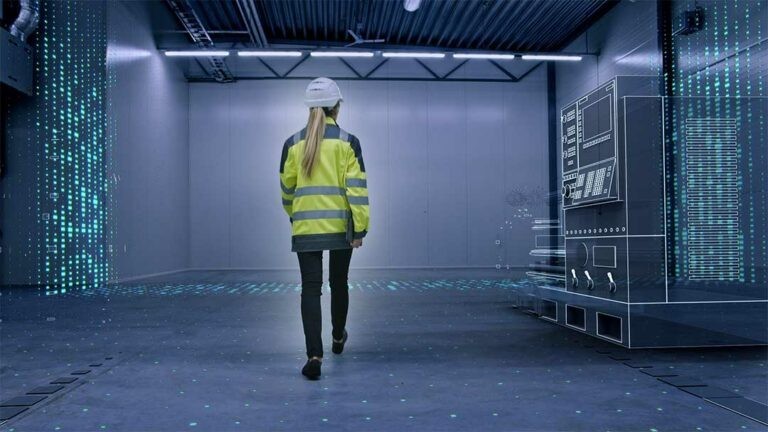
Efficiency Improvement in Logistics and Supply Chain Management – Best Practices
AI-Supported 3D Simulation for Optimization of Warehouse Management and Supply Chain
These reference projects show how AI-supported 3D service apps contribute to efficiency improvement in logistics and supply chain management.
Implementation and benefits:
We have implemented advanced AI-supported 3D simulation tools to optimize warehouse management and supply chain processes. These technologies enable precise and dynamic planning of warehouse layouts and logistics operations.
Improving warehouse and delivery processes:
By simulating different scenarios, companies can identify and eliminate bottlenecks, improve the efficiency of their warehouses and supply chains, and reduce overall operational costs.
Successes and process optimization:
The introduction of these 3D simulation tools has led to significant improvements in logistics performance. Companies have not only been able to shorten their delivery times but also improve their inventory control and resource management.
Additional benefits:
These technologies allow for better adaptation to market changes and increased transparency throughout the entire supply chain. They support strategic decision-making and enable proactive responses to supply and demand changes.

Healthcare and Medical Training – Best Practices
Use of AI-Supported 3D Service Apps in Medical Education
These reference projects highlight the benefits of AI-supported 3D service apps in healthcare, specifically in medical education and training.
Implementation and Benefits:
In medical education, we have implemented interactive 3D visualization tools for surgical procedures. These apps enable medical students and surgeons to practice and plan complex interventions in a virtual environment, improving understanding and skills.
Realistic and Risk-Free Training Scenarios:
By simulating realistic medical scenarios, aspiring doctors and surgeons can improve their skills without risking patient safety. This promotes more effective and safer patient care.
Success and Competence Development:
The use of these 3D service apps in medical training programs has led to improved surgical competence and a higher success rate in complex procedures. Students and professionals report a deeper understanding and increased confidence in their abilities.
Additional Benefits:
In addition to enhancing surgical skills, these technologies also enable continuous education and specialization of medical personnel. The ability to simulate rare cases contributes to the advancement of medical research and treatment methods.
How to GO NEXT.
We are Your Reliable Partner for 3D AI Service Apps in Business.
- Consultation: We analyze your requirements in the field of AI-supported 3D service apps and provide comprehensive consultation.
- Implementation: We develop customized AI-supported 3D service apps, specifically tailored to the needs of your business.
- Support: We offer continuous support and updates to ensure that your AI-based systems remain efficient and up-to-date.
Utilize the potential of AI-supported 3D service apps to fully realize the potential of your business.
What You Can Expect from a Service AI App Demo:
Concrete Examples: Experience how AI-supported 3D service apps can transform your business in real use cases.
Interactive Experience: Learn more about the benefits of AI-supported 3D service apps and how this technology can be integrated into your business.
Individual Consultation: Our experts are available to discuss your individual requirements in the field of AI-supported 3D service apps and offer tailored solutions.
FAQ on Service AI
What is a service AI?
A service AI is a type of Artificial Intelligence that focuses on customer service and support.
The idea is that service AIs are capable of interacting with customers and assisting them in solving problems. Essentially, this means that service AIs can understand natural language and respond appropriately to inquiries and comments.
There are various types of service AIs, but one of the most commonly used systems is IBM Watson Assistant. IBM Watson Assistant is a cloud-based system that allows companies to create and train their own service bots. Watson Assistant is constantly learning and improves with each interaction.
What benefits can arise for a company in machinery and plant engineering from the introduction of an AI-supported Augmented Reality service glasses?
There are a multitude of benefits for companies in machinery and plant engineering when they introduce an AI-supported Augmented Reality service glasses. With the help of this modern technology, employees can receive visually supported instructions projected directly onto the field of view of the glasses, ensuring each step of work is performed correctly.
- This reduces error rates,
- the expertise of the expert can be digitalized and transferred to other employees, while
- customer satisfaction and
- employee satisfaction increases,
- the turnover rate decreases, and
- the stress that employees are subjected to can be reduced.
If you are interested in such an innovative solution, it is worth speaking with our experts at Visoric GmbH in Munich.
With AI, AR, and Visoric, almost anything is possible - take advantage of these modern technologies and make your company fit for the future. We would be happy to advise you personally.
What potential do service AIs hold in the fields of mechanical engineering, the automotive industry, and aerospace?
The service AI, a combination of Artificial Intelligence with Augmented Reality (AR) and Virtual Reality (VR), has the potential to revolutionize approaches to mechanical engineering, automobile design, and processes in aerospace.
With the ability of service AIs to virtually represent complex machinery with incredible accuracy and overlay informative visuals on our physical environment, they open countless possibilities in these and many other industries that were impossible before the availability of service AI technology.
What is meant by machine identification using AR glasses?
The identification of machines using AR glasses is a process that allows users to identify specific machines through the use of Augmented Reality (AR) technology.
This involves the use of special software and hardware devices that can be worn on the head and face, such as glasses that enable visual recognition of objects and other data in their surroundings.
This type of technology has become increasingly popular in recent years, with applications ranging from industrial maintenance to medical diagnosis.
What advantage do AR glasses with Visoric’s AI apps offer in the field of industrial repair and maintenance?
In the field of industrial repair and maintenance, AR glasses with Visoric's AI apps enable workers to quickly and accurately identify the parts of a machine that need to be repaired or serviced. By accessing the necessary instructions, they can also be guided to perform repairs more effectively.
What advantage do AR glasses with Visoric’s AI apps offer in the field of aviation?
In the field of aviation, AR glasses with AI apps from Visoric enable pilots to have a better situational awareness in the cockpit, as they can see information about the speed, altitude, and course of the aircraft at all times. AR glasses with AI apps from Visoric can also be used to display detailed navigation data during the flight.
How can AR glasses with Visoric’s AI apps improve the control of robots?
Augmented Reality (AR) glasses, equipped with AI applications from Visoric, are used to improve the control of robots in industrial environments. By providing operators with an enhanced view of their robot's surroundings, AR glasses with Visoric's AI apps can contribute to faster and more accurate decision-making when controlling robotic arms or other high-precision machines.
Why is Visoric GmbH the right partner when it comes to the conception, design, and realization of AI-supported 3D service apps?
At Visoric, we have a team of experienced engineers, data scientists, and software developers who possess extensive knowledge in the field of AI-based 3D service apps.
We offer a unique combination of sophisticated algorithms embedded in intelligent systems that optimize your workflows and create maximum efficiency.
If you are looking for an innovative solution based on cutting-edge technology, then Visoric is the perfect partner for you. Contact us today to learn more about our services and how we can help you realize your vision of an AI-based 3D service app.
What is an example of a service that uses AI and Text 2 AI in the automotive sector?
What is an example of a service that uses AI and Text 2 AI in the automotive sector? An example of a service that uses AI and Text 2 AI in the automotive sector is the automatic diagnosis of vehicle problems. Such a system can analyze and interpret the error messages sent by a vehicle's computer to identify potential issues.
The system can then generate the corresponding error codes and possible solutions in natural language and relay this information to the mechanic or the vehicle owner.
This can help to shorten the time for diagnosis and reduce repair costs by more quickly identifying the correct problem.
Can a Service AI System Be Integrated into an Augmented Reality Glass Like Microsoft’s HoloLens to Offer a Revolutionary Tool to Mechanical Engineers, the Automotive Industry, or Aerospace?
Yes, a service AI system can be integrated into an augmented reality glass like Microsoft's HoloLens, offering a revolutionary tool to mechanical engineers, the automotive industry, and aerospace.
This technology integration not only provides these industries with additional insights but also allows them to interact with their machines in ways that were previously impossible.
For instance, with augmented reality glasses, mechanical engineers can "see" inside machines and track the interaction of internal components in real-time.
Moreover, they can overlay information about the machine's operation over their field of vision, enabling them to quickly identify problems or irregularities within the machine.
How Can Augmented Reality Glasses Help Companies in the Automotive Industry?
In the automotive industry, augmented reality glasses can help companies develop new models much more quickly. By creating interactive 3D models of vehicles with all their parts and mechanisms, technicians could navigate the virtual environment of a vehicle and test various components before a prototype is even built. Moreover, they could inspect vehicles remotely and perform preventive maintenance on large fleets of vehicles without having to leave their office.
How Can AI-Supported AR Experiences Be Effectively Utilized in the Field of Aerospace Engineering?
In aerospace engineering, an AI-supported AR experience could enable pilots to have a more intuitive control over their aircraft's systems and alert them to potential hazards along their route. It could also facilitate remote monitoring of aircraft by ground staff, using detailed 3D simulations for repairs or maintenance tests without the need for the aircraft to be physically present in the hangar.
What is Guided Maintenance?
Guided Maintenance is a comprehensive approach to the maintenance of facilities, where advanced technologies are used to optimize the effectiveness of maintenance activities.
The benefits of Guided Maintenance:
- Guided Maintenance helps companies to identify, monitor, and resolve issues that could impair system performance.
- It can also be used for planning upgrades or other future changes to your system.
- With Guided Maintenance, companies can track the status of their facilities over time and gain insights into the efficiency of their maintenance strategies.
- Using metrics such as availability rate, Mean Time Between Failures (MTBF), Mean Time Between Repairs (MTBR), and error rate, companies can better understand through Guided Maintenance how effectively their maintenance strategies have improved system performance and reliability over time.
What Advantage Do AR Glasses with Visoric’s AI Apps Offer in the Healthcare Sector?
n healthcare, AI-enabled AR glasses running Visoric apps assist doctors in quickly and accurately diagnosing the condition of their patients. The glasses with the application are also used to guide medical personnel through complex procedures such as surgeries and emergency treatments.
What Advantage Do AR Glasses with Visoric’s AI Apps Offer for Manufacturing Companies?
AI-powered AR glasses with Visoric's apps have already been successfully implemented in manufacturing companies to enhance production efficiency. For instance, AR glasses with AI apps from Visoric can provide workers with real-time step-by-step instructions for assembly and troubleshooting tips for on-site problems.
What Functions Can an AI-Powered Service Tool Offer for a Tablet in a Professional Environment?
What is Text 2 AI?
Text 2 AI refers to the use of artificial intelligence (AI) and machine learning (ML) for processing and analyzing texts. This can include automatic translation, creating summaries, identifying keywords, and much more. Text 2 AI systems are commonly used in applications such as search engines, chatbots, and voice assistants to enhance the processing and understanding of natural language.















